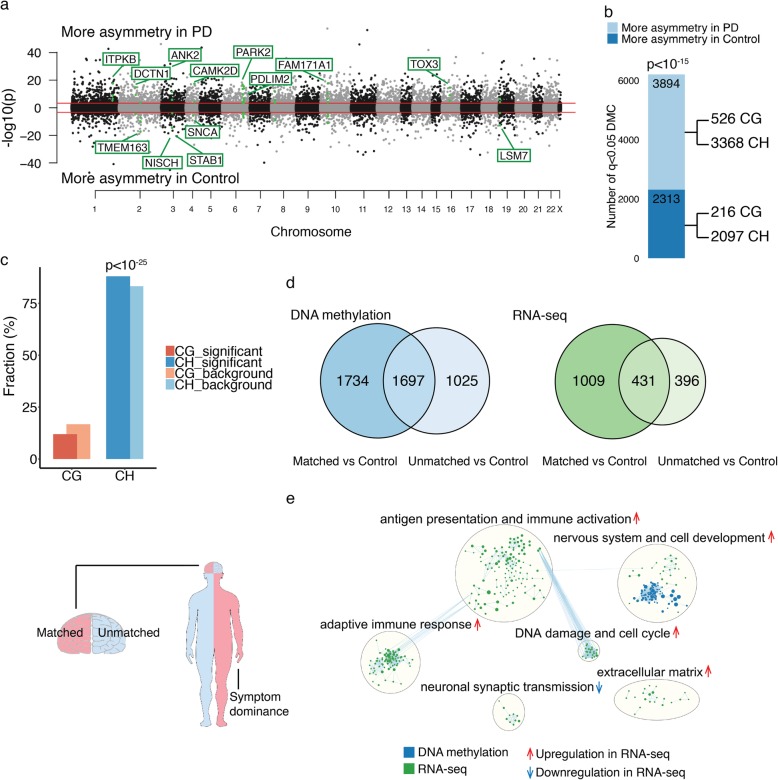Fig. 2.
Epigenetic differences across hemispheres are increased in PD and are relevant to the lateralization of clinical symptoms. a Manhattan plot comparing the hemispheric asymmetry in DNA methylation in neurons of PD patients and controls, after adjusting for age, sex, postmortem interval, and neuronal subtype proportion. DNA methylation differences were profiled at enhancers and promoters in prefrontal cortex neurons of 57 PD patients and 48 controls. −log10(p) refers to the significance of differentially methylated cytosines (DMC), with the sign corresponding to the diagnosis group with greater hemispheric asymmetry. Threshold for genome-wide significance (red line) is q < 0.05. Highlighted are genes implicated in PD risk (familial and/or identified by GWAS [50]) that have enhancers or promoters with 3 or more cytosines exhibiting hemispheric asymmetry in PD. b Comparison of the degree of hemispheric asymmetry in DNA methylation between PD patients and controls. The number of significant cytosine sites exhibiting more hemispheric asymmetry in PD or control neurons is shown. The p value represents the enrichment of cytosines with greater hemispheric asymmetry in PD relative to controls, by Fisher’s exact test. CpG and CpH contributions to hemispheric asymmetry are shown. c CpG and CpH involvement in hemispheric asymmetry changes in PD. The percent number of CpG or CpH sites significantly involved in hemispheric asymmetry changes in PD (relative to background) is shown. The enrichment of cytosine context was determined by hypergeometric test. d DNA methylation and transcriptional differences relevant to the lateralization of PD symptoms. Venn diagram showing the number of genes affected by differential methylation (left panel) or exhibiting differential expression (right panel) in the symptom-dominant (matched) or non-dominant (unmatched) PD hemisphere, relative to controls (DNA methylation: n = 17 PD-matched, 20 PD-unmatched, 48 controls; RNA-seq: n = 13 PD-matched, 11 PD-unmatched, 12 controls). e Pathway analysis of genes epigenetically and transcriptionally altered in neurons of the PD hemisphere matched or unmatched to side of symptom predominance, relative to control neurons. Only pathway clusters with nodes having greater changes in the hemisphere matched to PD symptom dominance are shown. Pathway enrichment analysis of DNA methylation data was done by g:Profiler (blue nodes) and of RNA-seq data was done by GSEA preranked (green nodes). Epigenetically and transcriptionally dysregulated pathways in PD hemispheres were merged in Enrichment Map using q < 0.05 pathways. Pathways up- or downregulated in PD hemispheres depicted by red or blue arrows, respectively, as determined by GSEA

